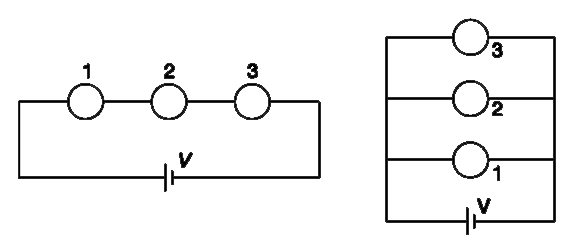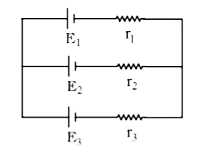Three ammeters — 1, 2 and 3 have different internal resistances respectively. Internal resistance is known but are unknown. The angular deflection of pointer in each ammeter is proportional to the current. Initially, the three ammeters were connected in series to a voltage source (fig. a) and deflections for the three ammeters were respectively. The three ammeters were then connected in parallel to the same voltage source (fig. b). This time the deflections were observed to be and respectively.
(a) Find .
(b) If but then which one is larger ?

The correct Answer is:(a)
(b)
Topper's Solved these Questions
Similar Questions
(A) : An ammeter is connected in series in the circuit.
(R) : An ammeter is a high resistance galvanometer.
View SolutionAn ammeter and a voltmeter of resistance R connected in seires to an electric cell of negligible internal resistance. Their readings are A and V respecitvely. If another resistance R is connected in parallel with the voltmeter
View Solution
Knowledge Check
Two ammeters, 1 and 2 have different internal resistances: r1 (known) and r2 (known). Each ammeter has scale such that the angular deviation of the needle for zero is proportional to the current passing through it. Initially, the ammeters are connected in series to a source of constant voltage. The deviations of the needles of the ammeter are θ1 and θ2, respecitively. The ammeters are then connected in parallel ot the same voltage source. This time, the deviations of the needles are θ'1 and θ'2 respectively. Find r2 in terms of r1,θ1,θ2,θ'1 and θ'2.
Ar1θ1θ'1θ2θ'2Br1θ2θ'1θ1θ'2Cr1θ2θ'2θ1θ'1Dr1θ2θ'2θ1θ'2An ammeter and a voltmeter of resistance R are connected in series to an electric cell of negligible internal resistance . Their readings are A and V respectively. If another resistance R is connected in parallel with the voltmeter , then
ABoth A and V increasesBBoth A and V decreasesCA decreases but V increasesDA increases but V decreases.Three batteries of emf E1,E2 and E3 and internal resistance r1,r2 and r3 are connected as shown. The current through the battery of emf E3 is zero if.
 AE1r2+E2r1=E3(r1+r2)BE1r2−E2r1=E3(r1+r2)CE1r2+E2r1=E3(r1+r2)DE1r1+E2r2=E3(r1+r2)
AE1r2+E2r1=E3(r1+r2)BE1r2−E2r1=E3(r1+r2)CE1r2+E2r1=E3(r1+r2)DE1r1+E2r2=E3(r1+r2)
An ammeter and a voltmeter of resistance R connected in seires to an electric cell of negligible internal resistance. Their readings are A and V respecitvely. If another resistance R is connected in parallel with the voltmeter
View SolutionAn ammeter and a voltmeter of resistance R connected in seires to an electric cell of negligible internal resistance. Their readings are A and V respecitvely. If another resistance R is connected in parallel with the voltmeter
View SolutionAn ammeter and a voltmeter of resistance R are connected in series to an electric cell of negligible internal resistance . Their readings are A and V respectively. If another resistance R is connected in parallel with the voltmeter , then
View SolutionThe resistance of ammeter is R0

View SolutionIn a hot wire ammeter the deflection angle θ of the pointer is related with the current I as
View Solution

